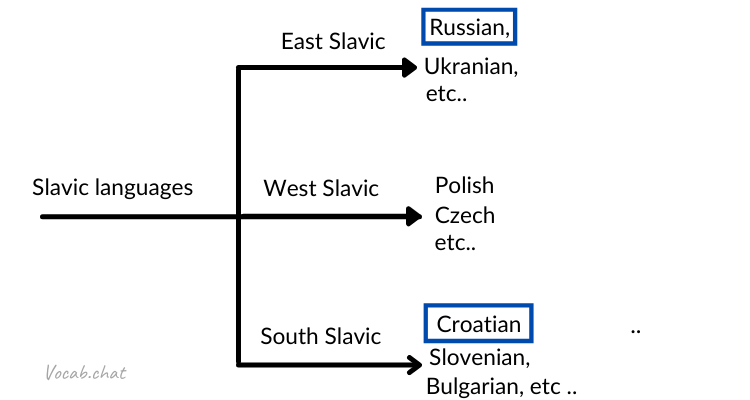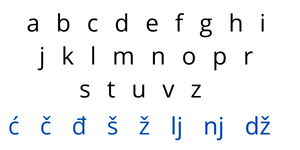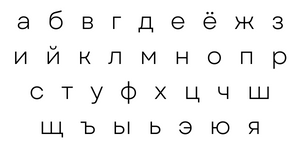Croatian and Russian: Language differences & similarities
At first glance, Croatian and Russian look like very different languages. Here is what the sentence “I am learning to speak a new language” looks like in Croatian and in Russian:
- Učim govoriti novi jezik
- Я учусь говорить на новом языке
(“Ya uchus' govorit' na novom yazyke”)
The first obvious difference between Croatian and Russian is that these languages use different writing systems: Croatian uses a Latin alphabet, while Russian uses a Cyrillic alphabet.
For those who are unfamiliar with the Cyrillic alphabet, we provide the phonetic transcription of the Russian phrase below (in blue).
With this phonetic transcription, it becomes apparent just how similar the vocabulary words are between the Croatian phrase and the Russian one:
| English | Russian | Croatian |
|---|---|---|
| to learn | учиться (uchit'sya) | učiti |
| to speak | говорить (govorit') | govoriti |
| new | новый (novyy) | novi |
| language | язык (yazyk) | jezik |
In the table, some of the words have different endings than they have in the sentences. This comes from the conjugation of verbs and also because Croatian and Russian are both languages in which word endings change to indicate grammatical function.
Vocabulary similarities between Croatian and Russian
There are many similar vocabulary words between Croatian and Russian. Here is a table with some more examples of them:
| English | Russian | Croatian |
|---|---|---|
| love | любовь (lyubov') | ljubav |
| language | язык (yazyk) | jezik |
| freedom | свобода (svoboda) | sloboda |
| peace | мир (mir) | mir |
| rich | богатый (bogatyy) | bogati |
| green | зеленый (zelenyy) | zelena |
| father | отец (otets) | otac |
| evening | вечер (vecher) | večer |
| hand | рука (ruka) | ruka |
| cheese | сыр (syr) | sir |
| book | книга (kniga) | knjiga |
| fish | рыба (ryba) | riba |
| dangerous | опасный (opasnyy) | opasno |
| silence | тишина (tishina) | tišina |
| water | вода (voda) | voda |
| sea | море (more) | more |
| force | сила (sila) | sila |
| bird | птица (ptitsa) | ptica |
| gold | золото (zoloto) | zlato |
| tall | высокий (vysokiy) | visok |
The reason why there are so many similar words between Croatian and Russian is that both these languages are Slavic languages.

Croatian is a South Slavic language while Russian is an East Slavic language. According to linguists, all Slavic languages originate from a common ancestor language which is referred to as the proto-Slavic language.
Croatian and Russian are languages that don't have articles
The most common words in English are articles (“the”, “a”, and “an”). This is not the case in Croatian and Russian, simply because neither of these languages has articles.
The absence of articles is fairly common among Slavic languages. One notable exception is Bulgarian which does have articles.
Slavic languages like Croatian and Russian are not the only languages in which articles don’t exist. Many other Indo-European languages don't have articles, this is the case with Latin and Sanskrit.
The Russian vs. the Croatian alphabet
The Croatian alphabet is called "Gaj's Latin alphabet", named after Ljudevit Gaj, who was a 19th-century Croatian linguist.

The Croatian alphabet has 8 letters that are not found in the English alphabet:
- Three of these letters are digraphs ('lj', 'nj', 'dž'). Although a digraph is composed of two parts, it is considered to be a single letter
- Several Croatian letters have a caron ( š, ž, č, and dž)
- The Croatian alphabet includes a “crossed d” (đ) which was introduced by the Serbian linguist Đuro Daničić to replace the older digraphs ‘dj’ and ‘gj’. The letter đ also exists in the Vietnamese alphabet.
While the Croatian alphabet is based on the Latin script, the Russian alphabet is based on the Cyrillic script.

The Russian alphabet has 3 more letters than the Croatian alphabet (33 vs 30). The Russian alphabet also differs more significantly from the English alphabet than the Croatian alphabet does.
- Two of the letters in the Russian alphabet are modifier letters (ь and ъ). These change the pronunciation of a neighboring letter. They are referred to as the “soft sign” (ь) and the “hard sign” (ъ).
- The Cyrillic script is used as the basis for the alphabets of several other Slavic languages besides Russian, for example, Bulgarian, Ukrainian, and Serbian (which uses both the Cyrillic and the Latin script)
Croatian vs Russian grammar
Croatian and Russian both have many grammatical cases
One of the things which make languages like Russian and Croatian difficult for language learners is their use of grammatical cases.
This is particularly the case for language learners coming from a language such as English where grammatical cases don't play a big role.
In English, the relationship between words in a sentence (their grammatical function) is mostly indicated through the use of prepositions (such as “to”, “from”, “in”, “at”, etc ..) as well as through word order.
There are many languages that indicate grammatical function through inflections ( this typically means changing the ending of words to indicate the grammatical relationships they have between each other in a sentence)
Croatian and Russian are both languages which use inflections to indicate a fairly large number of grammatical cases.
Russian has 6 grammatical cases (nominative, accusative, dative, genitive, instrumental, and prepositional ) while Croatian has 7 (nominative, accusative, dative, genitive, vocative, locative, instrumental).
Grammatical gender in Croatian and Russian
Croatian and Russian are both languages which have three grammatical genders (masculine, feminine, and neuter). This means that every noun is either masculine, feminine, or neuter.
Knowing the gender of a particular noun is necessary in order to determine the suffix that it gets when it is declined to a particular grammatical case.
There are certain patterns relating the ending of a noun to its gender. Although these patterns are helpful, there are also exceptions that must be memorized.
ConclusionAt first glance, a text written in Croatian looks quite different from a text written in Russian - because the two languages use different scripts (the Latin script for Croatian and the Cyrillic script for Russian)
But as they are both Slavic languages, Croatian and Russian share a number of similarities both in vocabulary as well as in grammar.
However as a South Slavic language, Croatian is closer to other South Slavic languages such as Serbian, than it is to Russian.
Similarly, Russian as an East Slavic Language is closer to other East Slavic languages such as Ukrainian and Belarusian, than it is to Croatian.